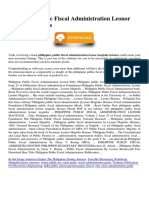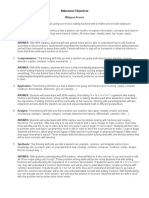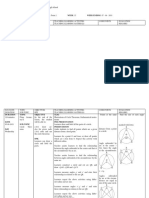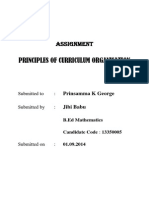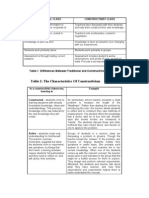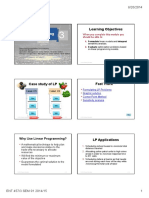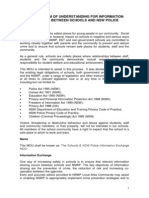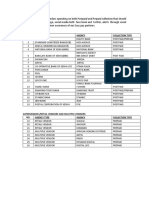Linear Programming Lesson Plan
Uploaded by
KoteswaraRao PLinear Programming Lesson Plan
Uploaded by
KoteswaraRao PLesson Objective(s): What mathematical skills and understanding will be developed?
A.REI.11
Students will solve real-world problems in order to develop an understanding of how to optimize given situations
using linear programming.
Lesson Tasks, Problems, and Activities (attach resource sheets): What specific questions, problems, tasks,
investigations, or activities will students be working on during the lesson?
Linear Programming word problems source: http://www.purplemath.com/modules/linprog.htm
In this activity, students will solve real-world optimization problems using linear programming.
1. The teacher will introduce the linear programming task and strategically pair/group students. Each
pair/group will be assigned one of the four problems, graph paper, rulers, color pencils, markers, chart paper,
and a graphing calculator. The students will read the problem to determine how to optimize the given task.
2. Pairs/groups will begin working to complete the task. The teacher will circulate the room to monitor the
students’ progress and ensure that students are on task. The teacher may ask thought provoking questions to
help students that may be struggling with the task.
3. After students have been working for 15 minutes, the teacher will ask students to copy their solutions on the
chart paper to present their solutions to the class.
4. Each pair/group will be asked to present their solution and explain the strategies that were used to complete
the task.
5. With the entire class, the teacher will pose the following questions:
What is a feasible region?
What is meant by optimization?
Is optimization the maximum or minimum?
What were some of the constraints in the problems?
Evidence of Success: What exactly do I expect students to be able to do at the end of the lesson, and how will I
know? That is, deliberate consideration of what performances will convince you (and any outside observer) that
your students have accomplished your objective.
Students will be able to determine the unknowns (x and y variables).
Students will be able to write and graph systems of inequalities.
Students will be able identify the feasible region, the constraints, and optimal situation for the task.
Lesson Launch Notes: Exactly how will you use the Lesson Closure Notes: Exactly what summary activity,
first five minutes of the lesson? questions, and discussion will close the lesson and provide
a foreshadowing of tomorrow?
The teacher will present the students with the following Teacher will ask students the following questions:
scenario: Easy Electronics Company wants to keep
production costs down. The company produces digital One pair/group will summarize the strategies used to solve
audio players and digital video players. The following each of the four problems.
information was posted by the factory production
manager on the company bulletin board:
Production per Shift
Player Minimum Maximum Cost per
Unit
Audio 600 1500 $55
Video 800 1700 $95
How much does it cost to produce 1000 audio
players? $55,000
Is it cheaper to produce an audio player or a
video player? an audio player
Can the company produce 2000 audio players
per shift? Why? No; the maximum number
of audio players that can be produced is
1500.
Notes and Nuances: Vocabulary, connections, common mistakes, typical misconceptions, etc.
Vocabulary: constraints, feasible region, linear programming, maximum, minimum, optimize
Resources: What materials or resources are essential Homework: Exactly what follow-up homework tasks,
for students to successfully complete the lesson tasks or problems, and/or exercises will be assigned upon the
activities? completion of the lesson?
Linear Programming Word Problem A school is preparing a trip for 400 students. The company who
Graph paper is providing the transportation has 10 buses of 50 seats each and
Ruler 8 buses of 40 seats, but only has 9 drivers available. The rental
Color pencils cost for a large bus is $800 and $600 for the small bus.
Calculate how many buses of each type should be used for the
Markers
trip for the least possible cost.
Chart Paper a. Identify the unknowns.
Graphing Calculators b. Write a system of inequalities to represent the
situation.
c. Draw the graph showing the feasible region.
d. List the coordinates of the vertices of the feasible
region.
e. Determine the number of each type of bus.
f. What is the minimum cost?
Post Lesson Reflections: What questions, connected to the lesson objectives and evidence of success, will you use
to reflect on the effectiveness of this lesson?
Were the students able to accomplish the task?
What were the students’ stumbling blocks?
Does the lesson need to be modified?
Did the lesson meet my expectations?
You might also like
- Philippine Public Fiscal Administration Leonor Magtolis Briones PDF67% (24)Philippine Public Fiscal Administration Leonor Magtolis Briones PDF1 page
- McKinsey & Company - BU Strategic Plan Template Book - 2001No ratings yetMcKinsey & Company - BU Strategic Plan Template Book - 200158 pages
- Aims and Objectives of Teaching Mathematics-2No ratings yetAims and Objectives of Teaching Mathematics-225 pages
- 5E Lesson Plan Template Department of Mathematics STC-Jan 2022No ratings yet5E Lesson Plan Template Department of Mathematics STC-Jan 20227 pages
- Math Lesson - Micro Teaching Pythagorean TheoremNo ratings yetMath Lesson - Micro Teaching Pythagorean Theorem6 pages
- Syllabus For B.ed From Mangalore University - 2semNo ratings yetSyllabus For B.ed From Mangalore University - 2sem31 pages
- Lesson Plan: San Antonio National High School100% (1)Lesson Plan: San Antonio National High School1 page
- Ma8551-Algebra & Number Theory (Iii Cse, It) Class Notes Unit-Iv Linear Diophantine Equations and Congruences Linear Diophantine EquationNo ratings yetMa8551-Algebra & Number Theory (Iii Cse, It) Class Notes Unit-Iv Linear Diophantine Equations and Congruences Linear Diophantine Equation19 pages
- Solving Equations Using Distributive Property Lesson PlanNo ratings yetSolving Equations Using Distributive Property Lesson Plan10 pages
- Remodeled Assessment Structure For Classes Vi To Viii 2019-20100% (1)Remodeled Assessment Structure For Classes Vi To Viii 2019-2023 pages
- Lesson Plan Framework Mathematics Secondary Pre Calc 11No ratings yetLesson Plan Framework Mathematics Secondary Pre Calc 113 pages
- Grade 7 Mathematics - Consolidated Curriculum - 2021No ratings yetGrade 7 Mathematics - Consolidated Curriculum - 202110 pages
- New Mathematics Baseline Test Grade 7 2020No ratings yetNew Mathematics Baseline Test Grade 7 202013 pages
- Relevance of Learning History of MathematicsNo ratings yetRelevance of Learning History of Mathematics14 pages
- Maha Raja Suraj MAL Instit UTE: Affliated To Guru Gobind Singh Indraprastha University100% (1)Maha Raja Suraj MAL Instit UTE: Affliated To Guru Gobind Singh Indraprastha University7 pages
- aims and objectives of teaching mathematics100% (1)aims and objectives of teaching mathematics10 pages
- Lunsford Grade3 Math Bar Graphing 5e Lesson PlanNo ratings yetLunsford Grade3 Math Bar Graphing 5e Lesson Plan6 pages
- BEd-02Sem-DrRameshM-Teaching of Biological ScienceNo ratings yetBEd-02Sem-DrRameshM-Teaching of Biological Science84 pages
- Unit 8 Planning Teaching-Learning Activities: StructureNo ratings yetUnit 8 Planning Teaching-Learning Activities: Structure28 pages
- Grade 9 Math Lesson Plan Day/date: Friday, 5 November 2021 Duration: 40 Minutes Teachers: Ms. Ruth: Cartesian CoordinatesNo ratings yetGrade 9 Math Lesson Plan Day/date: Friday, 5 November 2021 Duration: 40 Minutes Teachers: Ms. Ruth: Cartesian Coordinates1 page
- Class - 11 Maths Lesson Plan Chapter Wise Topic Wise CH 2 Relations and Functions (2024-25)No ratings yetClass - 11 Maths Lesson Plan Chapter Wise Topic Wise CH 2 Relations and Functions (2024-25)50 pages
- Circular Trigonometry Function Lesson Plan - Class 11 Math Lesson PlanNo ratings yetCircular Trigonometry Function Lesson Plan - Class 11 Math Lesson Plan7 pages
- 1086327380class X-Maths Resource Material 2015No ratings yet1086327380class X-Maths Resource Material 2015234 pages
- Byte Con Fiden Tial Don Otc Opy: Model Name: Ga-H110M-S2HNo ratings yetByte Con Fiden Tial Don Otc Opy: Model Name: Ga-H110M-S2H50 pages
- A Full-Scale Fluvial Flood Modelling Framework Based On A High-Performance Integrated Hydrodynamic Modelling System (HiPIMS)No ratings yetA Full-Scale Fluvial Flood Modelling Framework Based On A High-Performance Integrated Hydrodynamic Modelling System (HiPIMS)42 pages
- Related: Ask 3: Describing Actions Using The PassivesNo ratings yetRelated: Ask 3: Describing Actions Using The Passives4 pages
- Basic Technical Mathematics With Calculus 10th Edition by Washington ISBN Solution Manual100% (41)Basic Technical Mathematics With Calculus 10th Edition by Washington ISBN Solution Manual74 pages
- Federal Reserve Bank of Kansas City, Kansas City, MO 64198, USANo ratings yetFederal Reserve Bank of Kansas City, Kansas City, MO 64198, USA14 pages
- Group 7 Homework Chap 5 Introduction To POMNo ratings yetGroup 7 Homework Chap 5 Introduction To POM8 pages
- Fundamentals of Security in Operating SystemsNo ratings yetFundamentals of Security in Operating Systems4 pages
- Title: Tilt Cylinder Model Number: 863 Serial Number: 514440001 & Above, 514540001 & Above, 514640001 & AboveNo ratings yetTitle: Tilt Cylinder Model Number: 863 Serial Number: 514440001 & Above, 514540001 & Above, 514640001 & Above3 pages
- Topic: Remote Sensing Platforms: Dr. Md. NazimNo ratings yetTopic: Remote Sensing Platforms: Dr. Md. Nazim17 pages
- KPLC - Prepaid - Vendors - List of Easy Pay Partners 23 - 05 - 2017No ratings yetKPLC - Prepaid - Vendors - List of Easy Pay Partners 23 - 05 - 20171 page
- 01-Central de Deteção-Honeywell-Galaxy Dimension 96-Manual de Utilizador - enNo ratings yet01-Central de Deteção-Honeywell-Galaxy Dimension 96-Manual de Utilizador - en48 pages
- Characterization and Reuse of Kiln Rollers Waste in The Manufacture of Ceramic Floor TilesNo ratings yetCharacterization and Reuse of Kiln Rollers Waste in The Manufacture of Ceramic Floor Tiles7 pages
- Microeconomics - Tutorial Practice Attempt 5No ratings yetMicroeconomics - Tutorial Practice Attempt 56 pages
